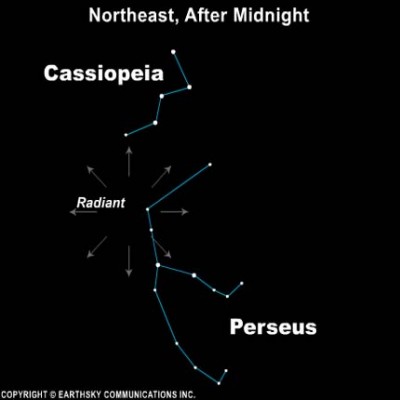10:00 AM | *Perseid meteor shower peaks on Monday night, but viewing should be good this weekend*
Paul Dorian
The radiant point for the Perseid meteor shower is in the constellation Perseus. But you don’t have to find a shower’s radiant point to see meteors. Instead, the meteors will be flying in all parts of the sky. Courtesy EarthSky Communications, Inc.
Overview
The annual Perseid meteor shower is well underway and will reach a peak early next week (Monday 8/12 -Tuesday 8/13). The viewing at the peak time this year will be troubled by moonlight from a nearly full moon. However, the upcoming weekend could offer pretty favorable conditions as nighttime skies should be mainly clear in the Mid-Atlantic region and the moonlight interference will be less of an issue. The Perseid meteor shower comes every August as the Earth passes through a cloud of dust that comes from Comet Swift-Tuttle as it approaches the sun.
Details
The Perseid meteor shower has already begun and it will slowly ramp up in activity this week reaching a peak around the night of August 12/13 (next Monday/Tuesday). Unfortunately, the moon becomes full on the 15th of August and the nearly full moon will likely drown out some meteors at the peak time early next week. For this reason, it would actually be worthwhile to view this weekend as there may be as much or even more success than at peak time given the fact that the moon will be less of a problem than it will be early next week and the refreshing air mass coming our way will feature mainly clear nighttime skies. The best time for viewing is usually after midnight; however, there certainly can be some sightings during the late evening hours.
Every year, from around July 17 to August 24, our planet Earth crosses the orbital path of Comet Swift-Tuttle, the parent of the Perseid meteor shower. Debris from this comet litters the comet’s orbit, but we don’t really get into the thick of the comet rubble until after the first week of August. Earth's gravity pulls in chunks of small rocks from Comet Swift-Tuttle comprised of iron-nickel, stone, and other minerals. These small rocks turn into bright balls of hot gas when they enter the Earth's atmosphere. As darkness falls, the meteors appear to come from the constellation Perseus, hence the name; although late in the evening, the meteors actually originate higher in the sky than the constellation.
From mid-northern latitudes, the constellation Perseus, the stars Capella and Aldebaran, and the Pleiades cluster light up the northeast sky in the wee hours after midnight on August nights. The meteors radiate from Perseus.
It is estimated that Perseid meteoroids hit our atmosphere at about 132,000 miles per hour to produce the annual light show and this meteor shower is usually rich in “fireballs” because of the size of the parent comet. Comet Swift-Tuttle has a huge nucleus - about 26 kilometers in diameter - whereas most other comets are much smaller with nuclei only a few kilometers across. Comet Swift-Tuttle has a very eccentric – oblong – orbit that takes this comet outside the orbit of Pluto when farthest from the sun, and inside the Earth’s orbit when closest to the sun. It orbits the sun in a period of about 133 years. Every time this comet passes through the inner solar system, the sun warms and softens up the ices in the comet, causing it to release fresh comet material into its orbital stream. Typically, meteors are only the size of pebbles, some as small as a grain of sand, but Comet Swift-Tuttle produces a large number of meteoroids that are large enough to produce “fireballs”. In fact, the Perseid meteor shower is considered the “fireball champion” of all of the annual meteor showers.
Meteorologist Paul Dorian
Perspecta, Inc.
perspectaweather.com


